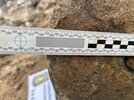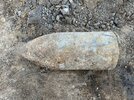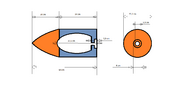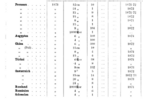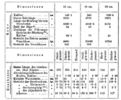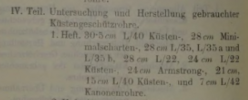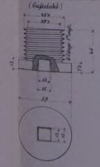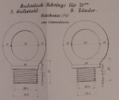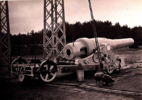
26cm Ring Kanone L/20 , M 1870 Krupp
Introduction where did that caliber come from and what accompanied it...
According to the design it is a Krupp system and certainly an export version which is not the same as the version introduced in Prussia 26 cm RK L/20 approx. C/1871 (the predecessor of the gun was C/ 1869) introduced in the Prussian army (navy). As you can see on the original Prussian drawing (Alpini) there is a large number of grooves in the lead jacket (rim) which is definitely not on the photo and drawing of the sample (Bob) - therefore in my opinion it is an export license from Krupp for another country.Here for an idea of the naval version of the gun carriage and its location on the SMS Kaiser
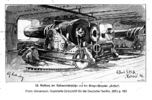
among others, another version in the 26cm caliber was demonstrated by Krupp in 1973 in Vienna (trade exhibition) i.e. 26cm (263mm) RK L/22 (projectile weight 184kg, and the shorter version of the projectile had 159kg)
-------------------------------------------------------------------------------------------------------------------------------------------------------------------------------------------------------------------------------------------
Because we have the caliber and dimensions, but we don't have the weight (which is mainly in the technical descriptions, not the shell length...) It will depend a lot on what symbols will be stamped on the body and the rim... if they clean it (and I hope they do), it would still be possible to measure the contents of the black powder chamber using water and a graduated cylinder...)Of course, we have the caliber 255 (254)

254mm:
The Krupp company sold production licenses in various calibers, for example 25.4cm (users of this caliber and Krupp license system: Russia, Italy, Japan....According to the smooth (Pb) rim, I am leaning towards the manufacturer: Russia (Obuchovsky plant - bought the license) and traditionally modified (simplified) the ammunition and then they had smooth,,Pb,, rims.Introduced to the Russian army under the designation 10 inch coastal gun. Here it is necessary to search for....
----------------------------------------
Because we have the caliber and dimensions, but we don't have the weight (which is mainly in the technical descriptions, not the bullet length...) It will depend a lot on what symbols will be stamped on the body and rim... if they clean it (and I hope they do), it would still be possible to measure the contents of the black powder chamber using water and a graduated cylinder...)Of course, we have the caliber 255 (254)

254mm:The Krupp company sold production licenses in various calibers, for example 25.4cm (users of this caliber and Krupp license system: Russia, Italy, ....
Note: Skoda is not yet considered as a license buyer, it is a very old design... the purchase of the Krupp license was much later.
Caliber 26 cm in Austria: The ground forces, i.e. siege and fortress artillery, operated, among others, the Krupp and Armstrong systems, with the Krupp system they had it on among others caliber: 24; 28; 30.5; 42 cm ...
A different situation is the Austrian Navy, there was used the caliber of the ship's cannon 26 cm (not a smooth Pb rim)
The caliber of 254 mm is not as strange as it may seem, but we have to limit according to the design of the ammunition (i.e. Pb shells) that eliminates the construction with a copper rim ... and that will not leave us much if we reject spherical ammunition.Or the design of the projectile is different (mainly the concept, location, material and function of the rim, the only thing in common is the shape of the cavity inside the projectile. (i.e. Armstrong system)



